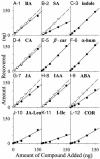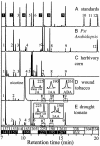Simultaneous analysis of phytohormones, phytotoxins, and volatile organic compounds in plants
- PMID: 12874387
- PMCID: PMC193599
- DOI: 10.1073/pnas.1633615100
Simultaneous analysis of phytohormones, phytotoxins, and volatile organic compounds in plants
Abstract
Phytohormones regulate the protective responses of plants against both biotic and abiotic stresses by means of synergistic or antagonistic actions referred to as signaling crosstalk. A bottleneck in crosstalk research is the quantification of numerous interacting phytohormones and regulators. The chemical analysis of salicylic acid, jasmonic acid, indole-3-acetic acid, and abscisic acid is typically achieved by using separate and complex methodologies. Moreover, pathogen-produced phytohormone mimics, such as the phytotoxin coronatine (COR), have not been directly quantified in plant tissues. We address these problems by using a simple preparation and a GC-MS-based metabolic profiling approach. Plant tissue is extracted in aqueous 1-propanol and mixed with dichloromethane. Carboxylic acids present in the organic layer are methylated by using trimethylsilyldiazomethane; analytes are volatilized under heat, collected on a polymeric absorbent, and eluted with solvent into a sample vial. Analytes are separated by using gas chromatography and quantified by using chemical-ionization mass spectrometry that produces predominantly [M+H]+ parent ions. We use this technique to examine levels of COR, phytohormones, and volatile organic compounds in model systems, including Arabidopsis thaliana during infection with Pseudomonas syringae pv. tomato DC3000, corn (Zea mays) under herbivory by corn earworm (Helicoverpa zea), tobacco (Nicotiana tabacum) after mechanical damage, and tomato (Lycopersicon esculentum) during drought stress. Numerous complex changes induced by pathogen infection, including the accumulation of COR, salicylic acid, jasmonic acid, indole-3-acetic acid, and abscisic acid illustrate the potential and simplicity of this approach in quantifying signaling crosstalk interactions that occur at the level of synthesis and accumulation.
Figures





Comment in
-
Hormones are in the air.Proc Natl Acad Sci U S A. 2003 Sep 2;100(18):10144-5. doi: 10.1073/pnas.1934350100. Epub 2003 Aug 26. Proc Natl Acad Sci U S A. 2003. PMID: 12941867 Free PMC article. No abstract available.
References
-
- de Bruxelles, G. L. & Roberts, M. R. (2001) Crit. Rev. Plant Sci. 20, 487-521.
-
- Kunkel, B. N. & Brooks, D. M. (2002) Curr. Opin. Plant Biol. 5, 325-331. - PubMed
-
- Zhu-Salzman, K., Salzman, R. A., Koiwa, H., Murdock, L. L., Bressan, R. A. & Hasegawa, P. M. (1998) Physiol. Plant. 104, 365-372.
Publication types
MeSH terms
Substances
LinkOut - more resources
Full Text Sources
Other Literature Sources
Miscellaneous

